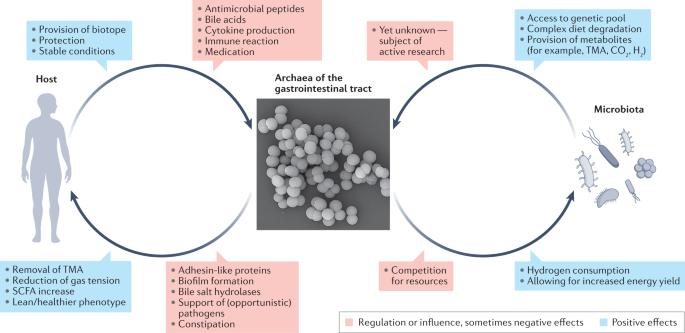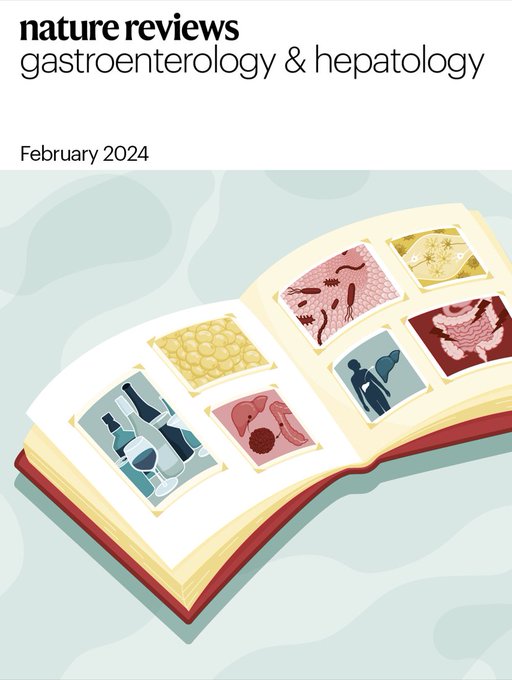人类胃肠道中的产甲烷古菌
IF 51
1区 医学
Q1 GASTROENTEROLOGY & HEPATOLOGY
引用次数: 12
摘要
人类微生物组与人类健康和疾病密切相关。除了细菌、病毒和真核生物外,人类胃肠道中还有大量古细菌,它们负责产生甲烷,临床甲烷呼气分析可以测量甲烷。甲烷是包括肠道甲烷原过度生长在内的各种疾病的重要读数。值得注意的是,在人类微生物组研究中,负责产生甲烷的古细菌在很大程度上被忽视了,因为它们的生物学特性与细菌无关,因此存在检测问题。因此,迄今为止,它们对健康和疾病的重要性在很大程度上仍不明确,特别是没有一个古细菌代表被认为是致病菌。在本《视角》中,我们将讨论有关产甲烷古细菌临床意义的现有知识。我们解释了古细菌对抗生素的独特反应及其对人体生理的负面和正面影响,并介绍了目前对甲烷作为诊断标志物的理解。古细菌是人类肠道微生物群中一个被忽视的成员。本视角探讨了古细菌的主要特征、它们在人类健康和生理学中的作用以及人类胃肠道中甲烷古细菌的临床意义。本文章由计算机程序翻译,如有差异,请以英文原文为准。

Methanogenic archaea in the human gastrointestinal tract
The human microbiome is strongly interwoven with human health and disease. Besides bacteria, viruses and eukaryotes, numerous archaea are located in the human gastrointestinal tract and are responsible for methane production, which can be measured in clinical methane breath analyses. Methane is an important readout for various diseases, including intestinal methanogen overgrowth. Notably, the archaea responsible for methane production are largely overlooked in human microbiome studies due to their non-bacterial biology and resulting detection issues. As such, their importance for health and disease remains largely unclear to date, in particular as not a single archaeal representative has been deemed to be pathogenic. In this Perspective, we discuss the current knowledge on the clinical relevance of methanogenic archaea. We explain the archaeal unique response to antibiotics and their negative and positive effects on human physiology, and present the current understanding of the use of methane as a diagnostic marker. Archaea are an overlooked member of the human gut microbiota. This Perspective discusses key characteristics of archaea, their role in human health and physiology, and the clinical relevance of methanogenic archaea in the human gastrointestinal tract.
求助全文
通过发布文献求助,成功后即可免费获取论文全文。
去求助
来源期刊
CiteScore
52.30
自引率
0.60%
发文量
147
审稿时长
6-12 weeks
期刊介绍:
Nature Reviews Gastroenterology & Hepatology aims to serve as the leading resource for Reviews and commentaries within the scientific and medical communities it caters to. The journal strives to maintain authority, accessibility, and clarity in its published articles, which are complemented by easily understandable figures, tables, and other display items. Dedicated to providing exceptional service to authors, referees, and readers, the editorial team works diligently to maximize the usefulness and impact of each publication.
The journal encompasses a wide range of content types, including Research Highlights, News & Views, Comments, Reviews, Perspectives, and Consensus Statements, all pertinent to gastroenterologists and hepatologists. With its broad scope, Nature Reviews Gastroenterology & Hepatology ensures that its articles reach a diverse audience, aiming for the widest possible dissemination of valuable information.
Nature Reviews Gastroenterology & Hepatology is part of the Nature Reviews portfolio of journals.

 求助内容:
求助内容: 应助结果提醒方式:
应助结果提醒方式:


